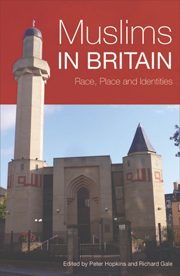Book contents
- Frontmatter
- Contents
- Acknowledgements
- List of contributors
- List of tables
- List of figures
- 1 Introduction: Muslims in Britain – race, place and the spatiality of identities
- Section 1 Gender, place and culture
- 2 Creating home spaces: young British Muslim women's identity and conceptualisations of home
- 3 ‘You seem very westernised to me’: place, identity and othering of Muslim workers in the UK labour market
- 4 Rethinking the identities of young British Pakistani Muslim women: educational experiences and aspirations
- 5 Race, ‘face’ and masculinity: the identities and local geographies of Muslim boys
- Section 2 Landscapes, communities and networks
- Section 3 Religion, race and difference
- Afterword
- Index
5 - Race, ‘face’ and masculinity: the identities and local geographies of Muslim boys
from Section 1 - Gender, place and culture
Published online by Cambridge University Press: 05 August 2013
- Frontmatter
- Contents
- Acknowledgements
- List of contributors
- List of tables
- List of figures
- 1 Introduction: Muslims in Britain – race, place and the spatiality of identities
- Section 1 Gender, place and culture
- 2 Creating home spaces: young British Muslim women's identity and conceptualisations of home
- 3 ‘You seem very westernised to me’: place, identity and othering of Muslim workers in the UK labour market
- 4 Rethinking the identities of young British Pakistani Muslim women: educational experiences and aspirations
- 5 Race, ‘face’ and masculinity: the identities and local geographies of Muslim boys
- Section 2 Landscapes, communities and networks
- Section 3 Religion, race and difference
- Afterword
- Index
Summary
Introduction
British Muslim young men occupy a sensationalised and demonised position in contemporary British society – indeed, we might describe them as the new folk devils of the British imagination. Popular discursive constructions of British Muslim young men coalesce around homogenised and stereotypical representations of dangerous and angry fundamentalists who engage in burning books (the Rushdie affair), rioting (e.g. in Bradford, Oldham) and planning, advocating and/or carrying out acts of terrorism (11 September 2001, 7 July 2005, summer 2006). In short, they are popularly feared as the archetypal ‘outsiders within’ – those who cannot be trusted and whose loyalty to the nation-state, and to the values and ideology of ‘Britishness’, cannot be counted upon.
These representations and panics raise important social justice questions. Extending Skeggs' (2004) theorisation of the representation of working-class subjects in public life, I would argue that British Muslims are being increasingly subjected to a narrow ‘forced telling of the self’ within popular and media discourse. For instance, it has become a common practice within news and current affairs reporting to parade an endless series of Muslim individuals, spokespersons and community representatives who are asked to explain their identities and to define their own positions vis-à-vis the various events and issues in question. This is not limited to Muslim men, as witnessed in autumn 2006, when fierce debates erupted around the wearing of the niqab, a debate in which Muslim women have been impelled to explain and situate themselves and their religious identities/practices through a simplistic, narrow dichotomy (wearing the veil vs not wearing it).
- Type
- Chapter
- Information
- Muslims in BritainRace, Place and Identities, pp. 74 - 92Publisher: Edinburgh University PressPrint publication year: 2009



